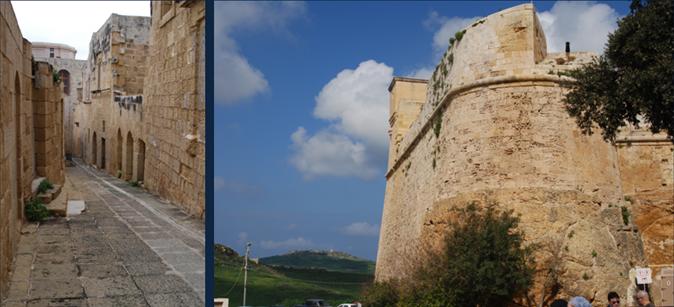A History of the Citadel
Known today as Cittadella by the Maltese and Gozitans, the citadel forms part of Rabat, the capital of Gozo. The citadel lies on a promontory, and is visible from afar. Given its strategic location, the promontory was densely and continuously occupied. Given its location, it is difficult not to imagine a prehistoric village being established on this promontory. This is supported by Bronze Age remains dicovered at it-Tokk, 50 meters away from the foot of the citadel.
Various Phoenician, Punic and Roman remains were discovered in the area around the citadel, and similarly to the situation at Malta, the old Roman city incorporated a large part of Rabat within its confines, possibly up to Vajringa Street and St Francis Square. This hypothetic boundary has been defined by the discoveries of various tombs and hypogea just outside this extent.
During the laying of the cathedral foundations in the 17th century, several monumental discoveries were made, which were assigned to the temple of Juno. 18th century writers noted inscriptions and several architectural fragments within the citadel, such as Jean Houel, who in his book, Voyage Pittoresque illustrates a female draped statue in the walls of the citadel, which statue today is found in the Gozo Archaeological Museum. A Latin inscription incorporated within the inner corner of the old entrance of the citadel, still exists today.
As with the situation at Mdina, the city was reduced to its current size with the arrival of the Arabs in 870AD. Milite Bernardo Street within the citadel, one of the oldest streets in Rabat, recalls the Islamic past of the island. The affects of the Turkish raid in 1551, on the island of Gozo, which left large parts of the castle in ruins, as can still be observed today. During the first quarter of the 17th century, the Knights of St John constructed the three bastions on the front of the citadel, although the population of the citadel reduced considerably after the earthquake of 1693.
During the 1950ís a second entrance was constructed, a few metres away from the original gateway, to access directly the cathedral square. Today the citadel is a scheduled Grade 1 site due to its military, historic, archaeological and landscape values. It is also a popular touristic site.
California Polytechnic State University
University of Malta
